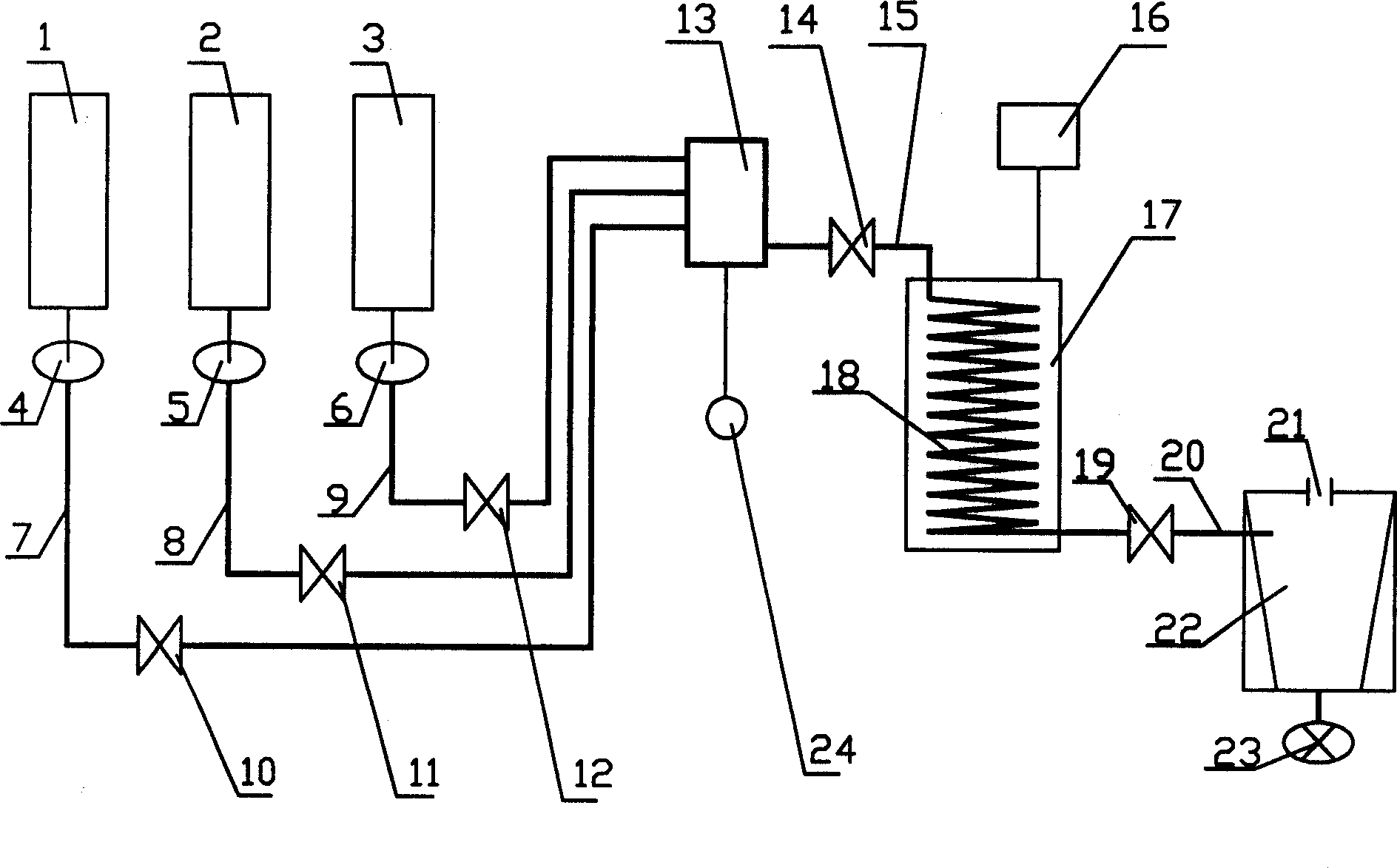Process and apparatus for producing o-phenylenediamine
A technology of o-phenylenediamine and o-dichlorobenzene, which is applied in the field of synthesis of aromatic organic amines, can solve problems such as small equipment production capacity, hidden safety hazards, and increased equipment investment, and achieve stable product quality, easy control of reaction conditions, The effect of saving investment
- Summary
- Abstract
- Description
- Claims
- Application Information
AI Technical Summary
Problems solved by technology
Method used
Image
Examples
Embodiment 1
[0025] Embodiment 1: A kind of reaction device, comprises the metering tank 1 that provides o-dichlorobenzene, the metering tank 2 that mainly provides catalyst, the metering tank 3 that provides liquefied ammonia, the pipeline reactor 17 that sets coil 18 inside, premixer Device 13, heater 16 links to each other with pipeline reactor 17, this heater 16 can select oil bath heater; Premixer 13 links to each other with booster pump 24, booster pump 24 can keep the pressure in the premixer 13 as required pressure. In order to facilitate the observation of the raw materials in the tank, the measuring tank 1 and the measuring tank 2 are designed as measuring tanks made of glass; the measuring tank 3 containing liquid ammonia is made of stainless steel, and the surface of the measuring tank 3 is provided with a glass liquid level gauge. The outlet of metering tank 1 is provided with high-pressure metering pump 4, and high-pressure metering pump 4 is connected to the inlet end of pre...
Embodiment 2
[0028] Embodiment 2: The reaction device is the same as in Embodiment 1. Adding concentration is 15% dilute ammonia water in metering tank 2, and this dilute ammonia water contains 0.979% cuprous chloride and 0.979% tetrabutylammonium bromide. Adjust the flow ratio of o-dichlorobenzene:dilute ammonia water:liquid ammonia=1.5:1:3.3 into the pipeline, and the outlet pressures of high-pressure metering pumps 4, 5, and 6 are all set to 15Mpa. (the weight ratio of actual cuprous chloride and liquefied ammonia is 0.5%: 1 now; The weight ratio of liquefied ammonia and o-dichlorobenzene is 1.076: 1.) Control the ammonolysis reaction temperature 150 ℃ in coil pipe 18, the pressure 15Mpa, keep the material flow rate of about 0.3ml / second, the calculated value of the ammonolysis reaction residence time is 19.625 minutes, all the other production methods are the same as in Example 1, and the o-phenylenediamine product with similar properties is obtained, and the yield is about 56%.
Embodiment 3
[0029]Embodiment 3: The reaction device is the same as in Embodiment 1. Adding concentration is 5% dilute ammonia water in metering tank 2, and this dilute ammonia water contains 1% cuprous chloride and 1% tetrabutylammonium bromide. Adjust the flow ratio of dichlorobenzene:dilute ammonia water:liquid ammonia=2:1:5 to enter the pipeline, and the outlet pressure of high-pressure metering pumps 4, 5, and 6 are all set to 16Mpa. (At this moment, the weight ratio of actual cuprous chloride and liquid ammonia is 0.38%: 1, and the weight ratio of liquid ammonia and o-dichlorobenzene is 1.223: 1.) Control reaction temperature 175 ℃, pressure 16Mpa, keep about 0.1ml / Second material flow rate, the ammonolysis reaction residence time calculated value is 58.88 minutes, and all the other production methods are with embodiment 1. The o-phenylenediamine product with similar properties was obtained with a yield of 68%.
PUM
| Property | Measurement | Unit |
|---|---|---|
| length | aaaaa | aaaaa |
| melting point | aaaaa | aaaaa |
Abstract
Description
Claims
Application Information
 Login to View More
Login to View More - R&D
- Intellectual Property
- Life Sciences
- Materials
- Tech Scout
- Unparalleled Data Quality
- Higher Quality Content
- 60% Fewer Hallucinations
Browse by: Latest US Patents, China's latest patents, Technical Efficacy Thesaurus, Application Domain, Technology Topic, Popular Technical Reports.
© 2025 PatSnap. All rights reserved.Legal|Privacy policy|Modern Slavery Act Transparency Statement|Sitemap|About US| Contact US: help@patsnap.com



